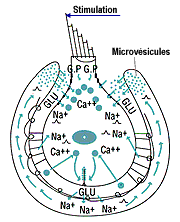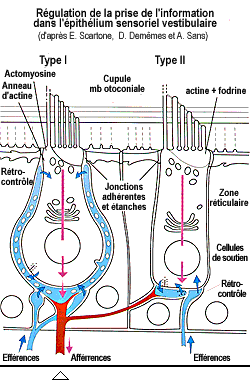Cell Physiology & Compensation

The hair cell enables the transformation of mechanical energy into nerve activity (mechanotransduction) relayed by the vestibular nerve to the central nervous system. As a result of shifts in the cupula and the otolithic membrane, angular acceleration in the case of the former and linear acceleration in the case of the latter, the cilia move, stimulating the hair cell.
The transformation of mechanical energy into a signal relayed by the vestibular nerve occurs at the apical pole of the sensory receptor cells of the ampullary crest and the utricular and saccular maculae. This apical pole, in contact with the endolymph, has a large number of projections: the stereocilia and the kinocilium.
The stereocilia, numbering between 50 and 120 per cell, are in rows in descending order of height and are positioned on either side of the kinocilium.
The kinocilium, connected to the adjacent stereocilia, triggers the displacement of all the stereocilia and constitutes the polarisation axis for the cilia as a whole.
When the stereocilia move towards the kinocilium, it produces, in the presence of calcium, an opening of the ion channels accompanied by the entry of calcium and potassium into the sensory cell.
This massive influx of calcium causes the almost immediate depolarisation of the cell and the release of a neurotransmitter contained in the vesicles of its basal pole. The neurotransmitter then stimulates the underlying afferent nerve endings that transmit the message to the brain.
Retro-control of data capture by the sensory cells
This increased stress brings into play a calcium-dependent regulation procedure, linked to the activities of the contraction system that modulates the message.
To avoid rupturing the stereocilia, following excessive stimulation, the vestibular sensory cells react by directly controlling the information. The mechanism is linked to the activities of the contractile proteins that are present at the apex of the hair cells. Under the effect of calcium, actin, myosin and tropomyosin contract, and allows for adjustments to the current for stereocilia stimulation.
Vestibular hair cells and calcium

The vestibular hair cell, the functional unit of balance, converts mechanical stimuli into nerve impulses. This process is linked to changes in membrane permeability, with the transition of calcium and potassium ions from the endolymph to inside the cell. The opening of the calcium channels can not take place unless the concentration of calcium in the endolymph is greater than or equal to 20 µmol. This massive influx of calcium into the hair cell is the source of the depolarisation of its basal pole that signals the release of the neurotransmitters that convey the message to the nerve centres.

From a patho-physiological perspective, the role of calcium is essential given that any abrupt rise in its concentration inside the hair cell results in over-stimulation, which in turn leads to vertigo.
VESTIBULAR COMPENSATION
Malfunction of the labyrinth, the balance sensor, prevents the coherent integration of information, subsequently triggering nystagmus, postural disorders and dizziness.
Vestibular compensation progressively restores balance.
Thanks to a greater understanding of these phenomena, the medical care provided to patients suffering from vertigo has improved.
INFLUENCE OF THE NERVE STRUCTURES AS A WHOLE
Vestibular compensation means the capacity of the vestibular system to seemingly recover from unilateral, partial or full vestibular loss. The gravity of the initial symptoms diminishes over time and eventually disappear, a striking example of the plasticity of the central nervous system.
The return to proper functioning is due to the influence of the different afferent systems, both central and peripheral, that substitute the damaged vestibular receptors.
Different nerve structures are involved in this substitution process: the spinal chord, the cerebellum, the healthy vestibular apparatus, the vestibular nuclei, cerebral cortex and the visual system. However, the most important sensory substitution comes from the undamaged labyrinth, essential when compensating for dynamic ocular (vestibule-ocular reflex) and postural (vestibule-spinal reflex) syndromes.
REBALANCING ELECTRICAL ACTIVITY
The set of symptoms following a unilateral lesion of the labyrinth stems from an imbalance in the electrical activity between the vestibular nuclei on either side. On the damaged side, there is a fall-off in the frequency of discharge, while on the undamaged side, there is a notable increase in the core electrical activity. During the compensation phase, electrical activity becomes practically symmetrical again, as a result of the activities of the nerve structures, especially the cerebellum, which reduce the excitement or inhibit the activity of the vestibular nuclei on the undamaged side, while exciting or disinhibiting those on the damaged side.





